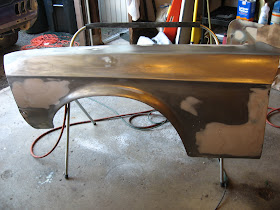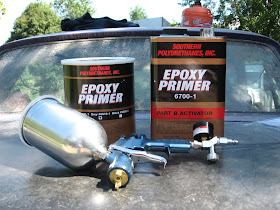The fenders have been a long, frustrating process. From the aspect of being rust free, they are good, solid--virtually perfect--fenders in that regard. From the aspect of being dent and ripple free....not sooo much. There were many small low spots or imperfections all over both fenders that I filled in with either plastic or fiberglass filler depending on the need, or just glazing putty. To put it briefly, I began overzealous with the filler and filled anything and everything. After I thought I was ready to start spraying, I decided I was then not happy with the amount of filler (basically out of fear of filler contour I might get in the final product) so I then proceeded to remove 70% of the filler I put down and put more effort into working out the low spots with a hammer and dolly. While painstaking, it was definitely in my favor as some of the low spots I was able to completely work out and required little more than a skim coat of glazing putty. By now this is probably boring you all, and you might not have even read this because you've already skipped down to the play by play action.

 These first two pics basically show what we're starting with. This is the filler I put on the first time before I decided to go and take most of it off. Much of the filler on the top was then reduced to small skim spots.
These first two pics basically show what we're starting with. This is the filler I put on the first time before I decided to go and take most of it off. Much of the filler on the top was then reduced to small skim spots.
 I used the infamous Southern Polyurethanes (SPI) Epoxy primer to shoot on the bare metal. SPI is best known for their epoxy.
I used the infamous Southern Polyurethanes (SPI) Epoxy primer to shoot on the bare metal. SPI is best known for their epoxy.

 For this first painting step, I was working with both fenders and the cowl. This is after shooting them with epoxy. I shot two coats of epoxy with 30 minute flash time in between coats.
For this first painting step, I was working with both fenders and the cowl. This is after shooting them with epoxy. I shot two coats of epoxy with 30 minute flash time in between coats.
 I then filled in minor imperfections with a skim coat of glazing putty. This pic was actually before I sprayed the cowl. I originally had the entire cowl and both fenders sprayed with Sikkens Washprimer, but after seeing some rust starting to come through that, I decided to sand it all back off and go with Epoxy, which is considerably more durable and corrosion resistant.
I then filled in minor imperfections with a skim coat of glazing putty. This pic was actually before I sprayed the cowl. I originally had the entire cowl and both fenders sprayed with Sikkens Washprimer, but after seeing some rust starting to come through that, I decided to sand it all back off and go with Epoxy, which is considerably more durable and corrosion resistant.
 After the epoxy was on, I laid down some SPI 2k filler primer. The Epoxy needs to be sprayed within seven days so I had to plan my timetable ahead to make sure I could get on all the coats in the right time frames. I sprayed on three coats of filler primer at a time. This stuff is great and is very thick. It fills in very well and sands easily to boot. Here I have applied a guidecoat to the cowl and am blocksanding it smooth with 180 grit.
After the epoxy was on, I laid down some SPI 2k filler primer. The Epoxy needs to be sprayed within seven days so I had to plan my timetable ahead to make sure I could get on all the coats in the right time frames. I sprayed on three coats of filler primer at a time. This stuff is great and is very thick. It fills in very well and sands easily to boot. Here I have applied a guidecoat to the cowl and am blocksanding it smooth with 180 grit.
 Of course I wasn't happy with everything after getting my final coats of fill primer on. I could still see some weird contours from the body filler that weren't natural for the car so once again I sanded off all the primer in select spots, removed the filler, bumped out the low spots better, and filled again.
Of course I wasn't happy with everything after getting my final coats of fill primer on. I could still see some weird contours from the body filler that weren't natural for the car so once again I sanded off all the primer in select spots, removed the filler, bumped out the low spots better, and filled again.
 After redoing everything, I again had to shoot the spots I fixed with epoxy followed by filling primer.
After redoing everything, I again had to shoot the spots I fixed with epoxy followed by filling primer.
Hey Josh, Great work! I stumbled onto your page from others that follow mine. Bumping out the low spots is the best way to go and skim coat the glazing putty. Too much filler and a body flex down the road, it might show a crack. Glazing putty has some flex but not in large batches.
ReplyDeleteKeep up the great work!
JB :-)
By now this is probably boring you all...